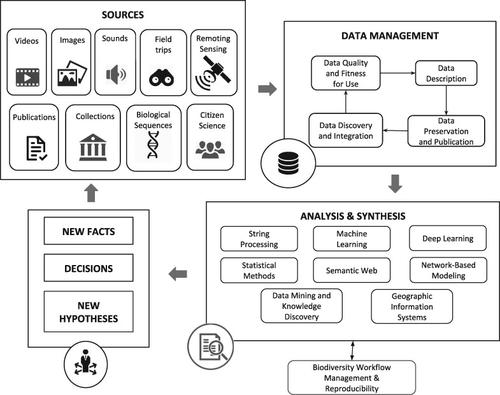当前位置:
X-MOL 学术
›
WIREs Data Mining Knowl. Discov.
›
论文详情
Our official English website, www.x-mol.net, welcomes your
feedback! (Note: you will need to create a separate account there.)
A survey of biodiversity informatics: Concepts, practices, and challenges
WIREs Data Mining and Knowledge Discovery ( IF 6.4 ) Pub Date : 2020-11-02 , DOI: 10.1002/widm.1394 Luiz M. R. Gadelha 1, 2 , Pedro C. Siracusa 1 , Eduardo Couto Dalcin 3 , Luís Alexandre Estevão Silva 3 , Douglas A. Augusto 4 , Eduardo Krempser 5 , Helen Michelle Affe 3 , Raquel Lopes Costa 5 , Maria Luiza Mondelli 1 , Pedro Milet Meirelles 6 , Fabiano Thompson 7 , Marcia Chame 4 , Artur Ziviani 1 , Marinez Ferreira Siqueira 3
WIREs Data Mining and Knowledge Discovery ( IF 6.4 ) Pub Date : 2020-11-02 , DOI: 10.1002/widm.1394 Luiz M. R. Gadelha 1, 2 , Pedro C. Siracusa 1 , Eduardo Couto Dalcin 3 , Luís Alexandre Estevão Silva 3 , Douglas A. Augusto 4 , Eduardo Krempser 5 , Helen Michelle Affe 3 , Raquel Lopes Costa 5 , Maria Luiza Mondelli 1 , Pedro Milet Meirelles 6 , Fabiano Thompson 7 , Marcia Chame 4 , Artur Ziviani 1 , Marinez Ferreira Siqueira 3
Affiliation

|
The unprecedented size of the human population, along with its associated economic activities, has an ever‐increasing impact on global environments. Across the world, countries are concerned about the growing resource consumption and the capacity of ecosystems to provide resources. To effectively conserve biodiversity, it is essential to make indicators and knowledge openly available to decision‐makers in ways that they can effectively use them. The development and deployment of tools and techniques to generate these indicators require having access to trustworthy data from biological collections, field surveys and automated sensors, molecular data, and historic academic literature. The transformation of these raw data into synthesized information that is fit for use requires going through many refinement steps. The methodologies and techniques applied to manage and analyze these data constitute an area usually called biodiversity informatics. Biodiversity data follow a life cycle consisting of planning, collection, certification, description, preservation, discovery, integration, and analysis. Researchers, whether producers or consumers of biodiversity data, will likely perform activities related to at least one of these steps. This article explores each stage of the life cycle of biodiversity data, discussing its methodologies, tools, and challenges.
中文翻译:

生物多样性信息学调查:概念,实践和挑战
人口空前的规模及其伴随的经济活动,对全球环境的影响越来越大。在世界范围内,各国对不断增长的资源消耗和生态系统提供资源的能力感到关切。为了有效地保护生物多样性,至关重要的是使决策者可以有效使用指标和知识。开发和部署用于生成这些指标的工具和技术需要能够访问来自生物收藏,现场调查和自动传感器,分子数据以及历史学术文献的可信赖数据。将这些原始数据转换为适合使用的综合信息需要经过许多改进步骤。生物多样性信息学。生物多样性数据遵循生命周期,包括计划,收集,认证,描述,保存,发现,整合和分析。无论是生物多样性数据的生产者还是消费者,研究人员都可能会开展与至少其中一个步骤有关的活动。本文探讨了生物多样性数据生命周期的每个阶段,并讨论了其方法,工具和挑战。
更新日期:2020-12-17
中文翻译:

生物多样性信息学调查:概念,实践和挑战
人口空前的规模及其伴随的经济活动,对全球环境的影响越来越大。在世界范围内,各国对不断增长的资源消耗和生态系统提供资源的能力感到关切。为了有效地保护生物多样性,至关重要的是使决策者可以有效使用指标和知识。开发和部署用于生成这些指标的工具和技术需要能够访问来自生物收藏,现场调查和自动传感器,分子数据以及历史学术文献的可信赖数据。将这些原始数据转换为适合使用的综合信息需要经过许多改进步骤。生物多样性信息学。生物多样性数据遵循生命周期,包括计划,收集,认证,描述,保存,发现,整合和分析。无论是生物多样性数据的生产者还是消费者,研究人员都可能会开展与至少其中一个步骤有关的活动。本文探讨了生物多样性数据生命周期的每个阶段,并讨论了其方法,工具和挑战。









































 京公网安备 11010802027423号
京公网安备 11010802027423号